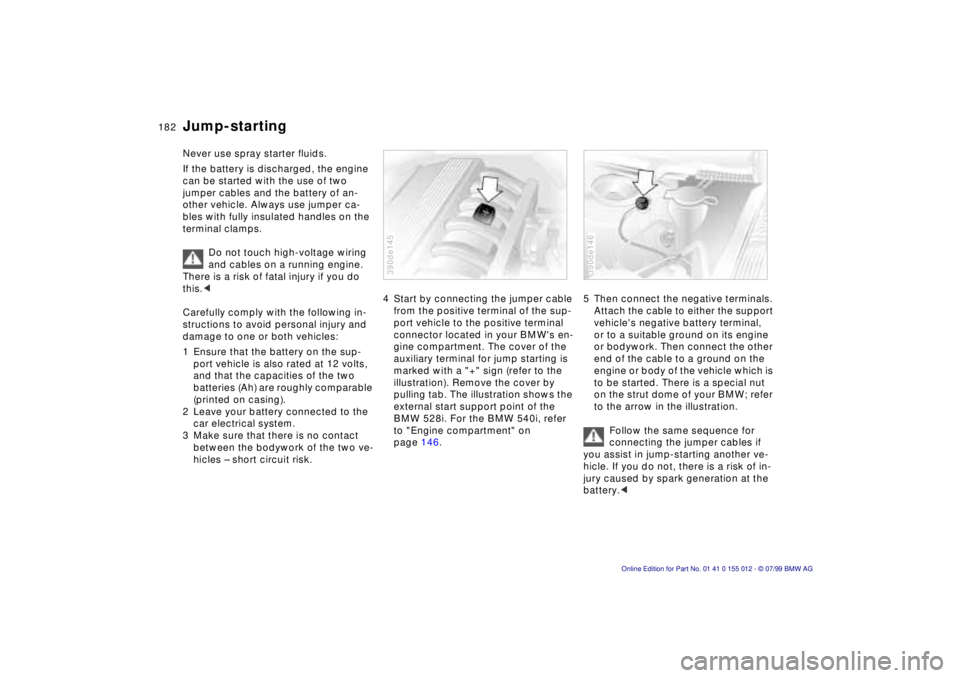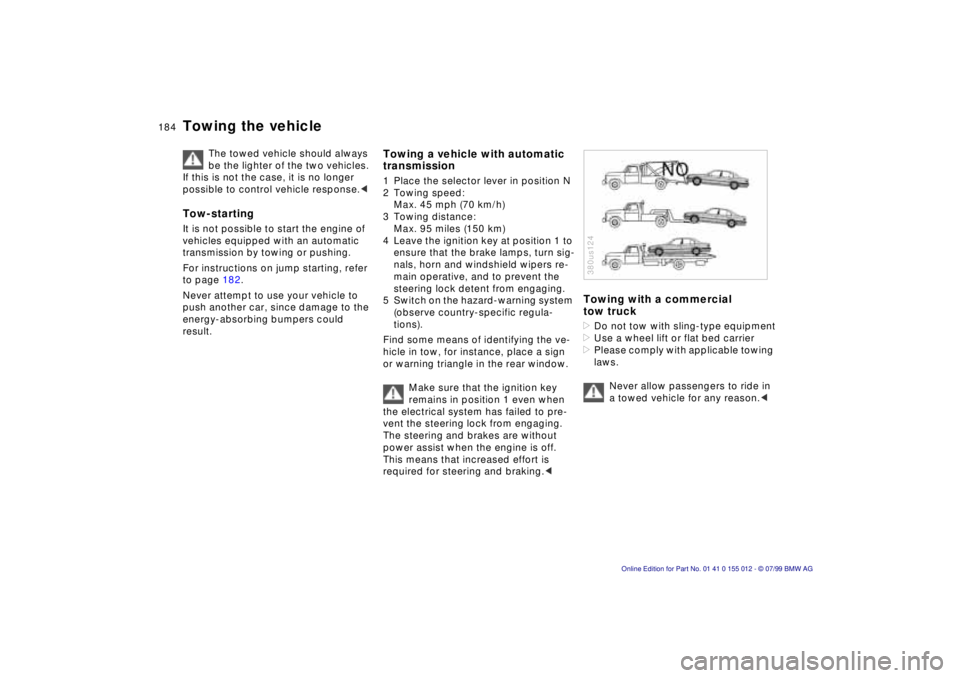Page 182 of 217

182n
Never use spray starter fluids.
If the battery is discharged, the engine
can be started with the use of two
jumper cables and the battery of an-
other vehicle. Always use jumper ca-
bles with fully insulated handles on the
terminal clamps.
Do not touch high-voltage wiring
and cables on a running engine.
There is a risk of fatal injury if you do
this.<
Carefully comply with the following in-
structions to avoid personal injury and
damage to one or both vehicles:
1 Ensure that the battery on the sup-
port vehicle is also rated at 12 volts,
and that the capacities of the two
batteries (Ah) are roughly comparable
(printed on casing).
2 Leave your battery connected to the
car electrical system.
3 Make sure that there is no contact
between the bodywork of the two ve-
hicles Ð short circuit risk.
4 Start by connecting the jumper cable
from the positive terminal of the sup-
port vehicle to the positive terminal
connector located in your BMW's en-
gine compartment. The cover of the
auxiliary terminal for jump starting is
marked with a "+" sign (refer to the
illustration). Remove the cover by
pulling tab. The illustration shows the
external start support point of the
BMW 528i. For the BMW 540i, refer
to "Engine compartment" on
page 146.390de145
5 Then connect the negative terminals.
Attach the cable to either the support
vehicle's negative battery terminal,
or to a suitable ground on its engine
or bodywork. Then connect the other
end of the cable to a ground on the
engine or body of the vehicle which is
to be started. There is a special nut
on the strut dome of your BMW; refer
to the arrow in the illustration.
Follow the same sequence for
connecting the jumper cables if
you assist in jump-starting another ve-
hicle. If you do not, there is a risk of in-
jury caused by spark generation at the
battery.< 390de146
Jump-starting
Page 183 of 217

183n
RepairsIndexOverview Controls Car care Technology Data
Jump-starting Towing the vehicle 6 Start the engine of the support
vehicle and let it run.
7 Start the engine on the vehicle need-
ing the jump-start, and allow it to run
as usual. If the first start attempt is
not successful, wait a few minutes
before another attempt in order to al-
low the discharged battery to re-
charge.
8 Before disconnecting the jumper ca-
bles from your BMW, turn on the
headlamps, the rear window de-
froster and the highest blower speed
and allow the engine to run at least
10 seconds to prevent a voltage
surge at the voltage regulator.
9 Then disconnect the jumper cables in
the opposite order.
Have the battery recharged if neces-
sary.
Tow fittingThe screw-in tow fitting is stored in the
onboard tool kit; be sure that it remains
in the vehicle at all times. This fitting
is designed for installation in the tow
sockets located at the front and rear of
the vehicle, and is intended for towing
on proper road surfaces only.
It should not be used to pull a vehicle
out of deep snow, mud, sand, etc. Al-
ways observe all applicable towing laws
and regulations.Access to tow socketsFront:
Apply pressure to the arrow symbol on
the cover panel to remove.390de087
Rear:
Apply pressure to the arrow symbol on
the cover panel to remove.
Screw the tow fitting in until it bot-
toms firmly. If this is not done, the
threads could be damaged.
Never attach tie-down hooks, chains,
straps, or tow hooks to tie rods, control
arms, or any other part of the vehicle
suspension, as severe damage to these
components will occur, leading to pos-
sible accidents.<
Use only a nylon towing strap to tow the
vehicle, since the inherent resilience of
this material helps protect both vehicles
from sudden jerking movements.394de088
Page 184 of 217

184n
Towing the vehicle
The towed vehicle should always
be the lighter of the two vehicles.
If this is not the case, it is no longer
possible to control vehicle response.<
Tow-startingIt is not possible to start the engine of
vehicles equipped with an automatic
transmission by towing or pushing.
For instructions on jump starting, refer
to page 182.
Never attempt to use your vehicle to
push another car, since damage to the
energy-absorbing bumpers could
result.
Towing a vehicle with automatic
transmission1 Place the selector lever in position N
2 Towing speed:
Max. 45 mph (70 km/h)
3 Towing distance:
Max. 95 miles (150 km)
4 Leave the ignition key at position 1 to
ensure that the brake lamps, turn sig-
nals, horn and windshield wipers re-
main operative, and to prevent the
steering lock detent from engaging.
5 Switch on the hazard-warning system
(observe country-specific regula-
tions).
Find some means of identifying the ve-
hicle in tow, for instance, place a sign
or warning triangle in the rear window.
Make sure that the ignition key
remains in position 1 even when
the electrical system has failed to pre-
vent the steering lock from engaging.
The steering and brakes are without
power assist when the engine is off.
This means that increased effort is
required for steering and braking.<
Towing with a commercial
tow truck>Do not tow with sling-type equipment
>Use a wheel lift or flat bed carrier
>Please comply with applicable towing
laws.
Never allow passengers to ride in
a towed vehicle for any reason.<380us124